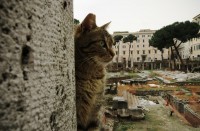 Rome is a city replete with cats. An estimated 250,000 cats live all over the city but seem to have a particular affinity for antiquity, living alone or in semi-feral colonies everywhere from the pyramid of Gaius Cestius to the Imperial Forum to the Colosseum. Cats draped over ancient ruins make picturesque subject matter for artists and tourists today just as cats going about their business did for Roman artists 2000 years ago.
Rome is a city replete with cats. An estimated 250,000 cats live all over the city but seem to have a particular affinity for antiquity, living alone or in semi-feral colonies everywhere from the pyramid of Gaius Cestius to the Imperial Forum to the Colosseum. Cats draped over ancient ruins make picturesque subject matter for artists and tourists today just as cats going about their business did for Roman artists 2000 years ago.
Though they appear charmingly relaxed and rakish in pictures, Roman cats just like any other stray cats suffer from illness, malnourishment, abuse and the many dangers of living in high traffic areas. Some of them are feral; many of them are abandoned. (It has sadly long been common in Italy for people to just dump their pets when they take off for summer vacation.) Traditionally Roman cats have relied on the kindness of strangers and of women known as “gattare” (crazy cat ladies, basically) who fed and cared for thousands of cats around the city as best they could. Even the most committed volunteers, like actress Franca Stoppi who, following in the footsteps of the great Italian actress Anna Magnani, tended to the cats at the Largo di Torre Argentina, couldn’t possibly see to all of their needs.
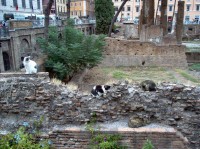 Her dedication to feeding, spaying or neutering and providing medical care for the dozens of cats who lived in the ruins of Pompey’s theater and other older Republican structures excavated in 1929, now a sunken central courtyard in the middle of a major thoroughfare of downtown traffic, took a huge toll on her finances and health. Silvia Viviani and Lia Dequel began helping Franca Stoppi with the Largo Argentina cats, but they realized even their combined efforts were insufficient to support almost a hundred cats.
Her dedication to feeding, spaying or neutering and providing medical care for the dozens of cats who lived in the ruins of Pompey’s theater and other older Republican structures excavated in 1929, now a sunken central courtyard in the middle of a major thoroughfare of downtown traffic, took a huge toll on her finances and health. Silvia Viviani and Lia Dequel began helping Franca Stoppi with the Largo Argentina cats, but they realized even their combined efforts were insufficient to support almost a hundred cats.
In 1993, Viviani and Dequel co-founded the Torre Argentina Roman Cat Sanctuary. They were able to create an ad hoc night shelter out of a cave-like area that had been excavated under the street. They used the cramped, dark, damp space for shelter and food storage for a year and a half. Things began to look up when the Anglo-Italian Society for the Protection of Animals got involved, providing them with material support and the benefit of their years of experience aiding needy animals in Italy. This gave them the push to start asking the many tourists fascinated with the cats for donations. They dressed up in their best clothes so people wouldn’t think they were begging for themselves and it worked.
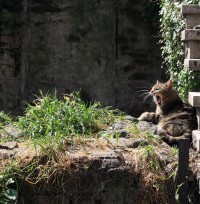 With some money coming in from tourists and from charity events, the sanctuary improved the food and converted the cave into a small but usable shelter. They were also able to start helping other sanctuaries and informal cat supporters around the city. Their spay and neuter program has been remarkably effective, peaking with 4,105 cats sterilized in 2008. Although the decline in donations and visitors as a result of the financial crisis crippled their program, last year they spayed or neutered 3,328 cats. To date, the Torre Argentina sanctuary has funded the sterilization of 28,000 cats, more than 10% of the city’s estimated cat population. Considering their shoestring budget and ornery patients, that’s one hell of an impressive statistic.
With some money coming in from tourists and from charity events, the sanctuary improved the food and converted the cave into a small but usable shelter. They were also able to start helping other sanctuaries and informal cat supporters around the city. Their spay and neuter program has been remarkably effective, peaking with 4,105 cats sterilized in 2008. Although the decline in donations and visitors as a result of the financial crisis crippled their program, last year they spayed or neutered 3,328 cats. To date, the Torre Argentina sanctuary has funded the sterilization of 28,000 cats, more than 10% of the city’s estimated cat population. Considering their shoestring budget and ornery patients, that’s one hell of an impressive statistic.
They also have a successful but modest adoption program, and for the many cats that don’t have the temperament, good health or conventionally good looks to find a loving, responsible home, they provide a permanent home for them in the sanctuary. A distance adoption program allows people all over the world to “adopt” one of these permanent residents by sending a monthly donation. In return they get pictures and updates about their long distance kitty.
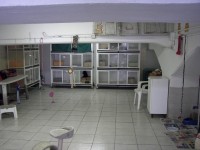 Volunteers clean the cages and feed and see to the medical needs of the animals starting every morning, seven days a week, at 8:00 AM. Because the space is so small, disease can spread like wildfire. To prevent this from happening, the volunteers are obsessive about cleaning. I don’t mean just wiping stuff down. I mean full-on sterilization of every litter scoop between every use, of every surface daily. Read the volunteer manual (pdf) to see what kind of standards they employ. I can’t even look my cat in the eye after reading that.
Volunteers clean the cages and feed and see to the medical needs of the animals starting every morning, seven days a week, at 8:00 AM. Because the space is so small, disease can spread like wildfire. To prevent this from happening, the volunteers are obsessive about cleaning. I don’t mean just wiping stuff down. I mean full-on sterilization of every litter scoop between every use, of every surface daily. Read the volunteer manual (pdf) to see what kind of standards they employ. I can’t even look my cat in the eye after reading that.
There’s just one problem: this whole thing is technically illegal. They’re squatters. The sanctuary was built without a permit and on an ancient monument. Even though it’s been in operation almost 20 years, for some reason this year government officials have cottoned onto it as a political issue and the refuge is now being threatened with eviction. Authorities, who clearly have not read the volunteer manual, say it’s a health hazard and that it compromises ancient remains. They say this as they build a new tram line right over those ancient remains, which might seem to some like a rather glaring hypocrisy.
The question has now been raised in parliament, with Democratic Party senator Vincenzo Vita submitting an interrogatory to the Culture Ministry demanding that the sanctuary be removed as an illegal construction. Meanwhile, the two agencies, one regional and one municipal, that oversee cultural heritage in the capital are engaged in a power play over the sanctuary while the mayor of Rome, Gianni Alemanno, a cat owner himself, wants it to stay where it is.
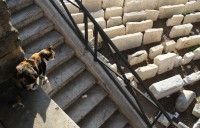 Then there’s the matter of Julius Caesar’s assassination. I didn’t blog about this story because it made me mad, but last month archaeologists from the Spanish National Research Council loudly announced that they had found the exact spot where dictator-for-life Gaius Julius Caesar was stabbed to death by a cabal of senators on March 15, 44 B.C. We know from a number of ancient sources that he was assassinated at the bottom of the curia of Pompey’s Theater. The SNRC team claims to have found the remains of a concrete structure built by Augustus Caesar, Julius’ nephew and heir, to memorialize the precise spot of the dastardly deed. What made me mad is that even though the story was picked up by news outlets all over the world dazzled by the words “Julius,” “Caesar” and “assassination,” the evidence presented was non-existent, nor had the so-called discovery been confirmed by any other archaeologists. Also, there were no pictures of the concrete structure, just of the general Torre Argentina site, which can easily be had for the Googling.
Then there’s the matter of Julius Caesar’s assassination. I didn’t blog about this story because it made me mad, but last month archaeologists from the Spanish National Research Council loudly announced that they had found the exact spot where dictator-for-life Gaius Julius Caesar was stabbed to death by a cabal of senators on March 15, 44 B.C. We know from a number of ancient sources that he was assassinated at the bottom of the curia of Pompey’s Theater. The SNRC team claims to have found the remains of a concrete structure built by Augustus Caesar, Julius’ nephew and heir, to memorialize the precise spot of the dastardly deed. What made me mad is that even though the story was picked up by news outlets all over the world dazzled by the words “Julius,” “Caesar” and “assassination,” the evidence presented was non-existent, nor had the so-called discovery been confirmed by any other archaeologists. Also, there were no pictures of the concrete structure, just of the general Torre Argentina site, which can easily be had for the Googling.
Still, it put Largo Argentina’s remarkable archaeological history in the spotlight, and it has provided a glamorous reference point for those opposed to the sanctuary. “How can we allow an unhygienic cat sanctuary to squat all over the place where Caesar was killed?!” It’s a large complex with four temples built at various times from the 4th to the 1st century B.C. The fact that the refuge is on the other side of the complex from the curia doesn’t keep opponents for going for the rhetorical flourish.
The Torre Argentina Roman Cat Sanctuary is willing to work with the city to relocate somewhere else in the archaeological area, but since the cats live there and nobody is crazy enough to even suggest they be moved, the sanctuary has to be where the cats are. They’re in discussions right now, and with elections coming up next spring, there is motivation to get it settled before a whole new crop of politicians take over.
Click here to send a letter of support for the sanctuary to city officials. To keep up with the story as it develops, see the sanctuary’s diary page. Have a virtual visit with the cats thanks to the this video: